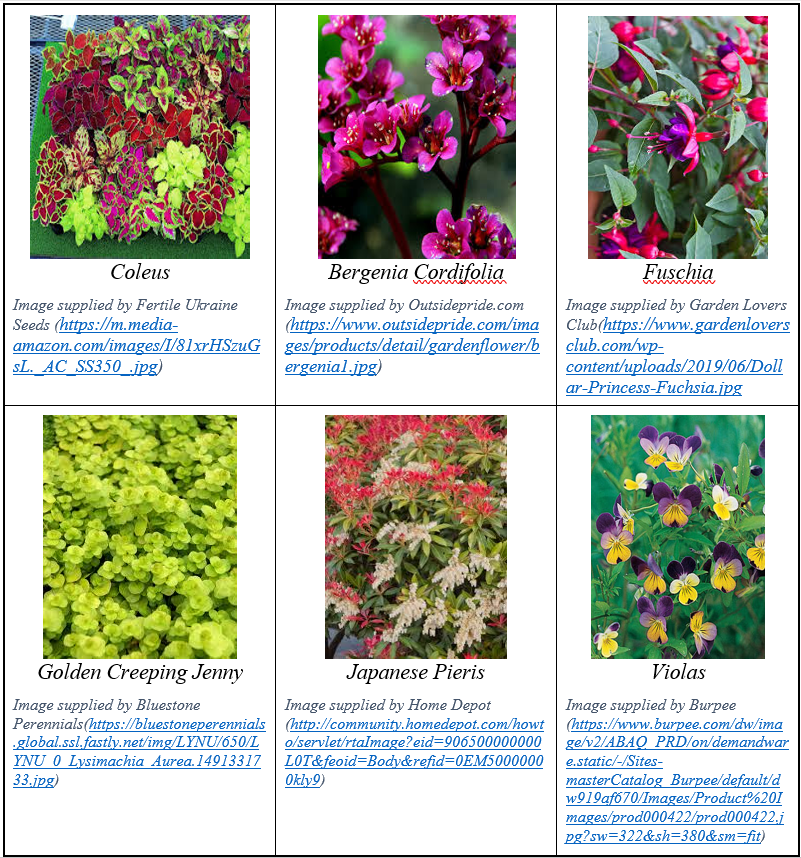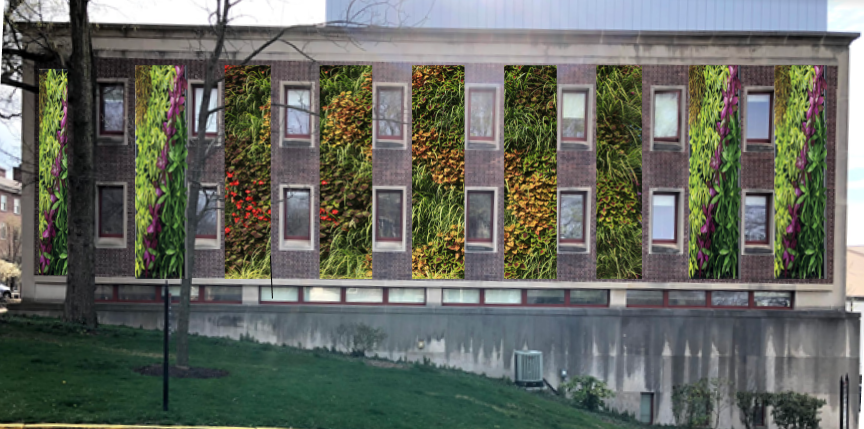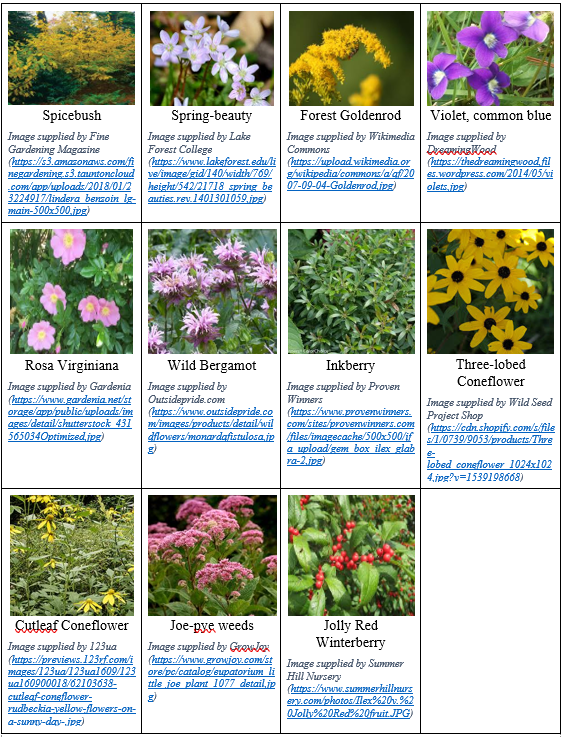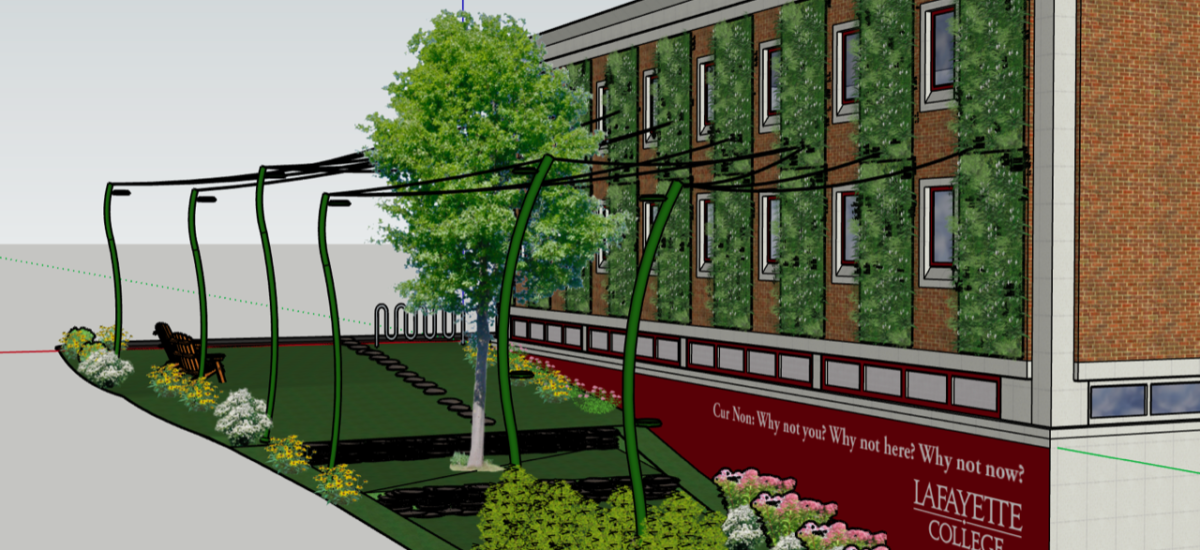Introduction
The Lafayette Gardens project was motivated to a large degree by attention to the current environmental debates, with the first among them being the climate crisis. Lafayette College, along with many other institutions around the country, has drafted a climate action plan that identifies their individual goals to become more sustainable. More specifically, Lafayette College has since updated its initial Climate Action Plan to the Climate Action Plan 2.0. The primary focus within the plan is to reach carbon net-neutrality before or by the year 2035 (2019 Climate Action Plan, 2019, p.3). There are different sustainable technological solutions that are being carried out to help the college reach this goal. Considering such goals, the implementation of a living wall, which covers an entire wall with plants, can help Lafayette College enforce its goals. Not only can it be beneficial to those on campus, but it can help with Lafayette’s relationship with other schools and communities, and has the potential to inspire others to implement similar projects.
This chapter focuses on how installing a living wall has many components that our team must take into account to effectively implement and maintain a living wall for a long period of time. If the wall is implemented and properly maintained, not only would Lafayette College be one step closer to their plan, but the benefits would be reaped by the individuals using the space and the wildlife. A living wall has various benefits, whether it is improving the students’ well-being, work productivity, or helping increase animal biodiversity through the choice of different plants (Perini et al., 2013). However, these benefits primarily depend on the plant choice, which leads to the second part of this section. Not only is the project focusing on the living wall that will be placed on the northeast side of the Acopian Engineering Center, but also the ground right next to it. Maximizing the benefits this area contains can help create a welcoming space that can be used by anyone. In order to effectively use this space, there are a variety of components that we must take a closer look at.
Literature & Sources
Living walls are steadily increasing in popularity across the country and has led to an increase in research as well. Living walls are quite complex as the structure is filled with plants that need to be able to survive vertically. There are numerous critical components that we must consider as there could be negative impacts on the wildlife, individuals, and the environment. In order to reap the benefits of the living wall, plant selection is crucial. Use of a variety of plants on both the wall and the ground (the two areas for this project), can help increase wildlife diversity, support for native species, and rehabilitate the area. Prance et al. (2014) support such claims as well; “diverse organisms, ecosystems, and ecological processes provide economic, environmental, and social benefits when interacting with managed open greens space” (Prance et al., 2014, p.789). Not only does the selection of plants help the environment, but the plants can release different scents that can “provide relief from anxiety and enhance relaxation, while also reducing discomfort in a variety of ways” (How Aromatherapy Can Help Students Achieve Academic Success, 2018).
There are companies that help manufacture living wall systems such as LiveWall. LiveWall is an American company that has been working towards helping people implement successful living walls, and have adequate research on how to select the best living wall for campus. The LiveWall system has been seen to “better attendance… reduce fatigue… increase output… enhance performance… [patients] recover faster… ease[s] anxiety… reduce noise… reduced heat… reduced carbon… save energy” and many more (Living Wall Benefits, 2020). Furthermore, green spaces in general hold benefits in aiding an individual’s well-being and can have further social benefits, especially in urban areas (Barton, 2018). The findings that we have discovered through our extensive research exemplifies the additional benefits of living walls and how it can be part of the solution towards tackling the issues of climate change, such as increasing urban biodiversity or having positive effects of hydrology (Loh, 2008, p.3). Other researchers have found similar findings including improved thermal performance, reduction of air pollution and noise, social benefits, visual effects, educational effects, habitation for urban wildlife, and economic benefits (Radić et al., 2019). Furthermore, the living wall that will be located on Acopian will be an indirect greening system that holds specific benefits like energy conservation for heating and cooling (Perini et al., 2013).
Our team carefully researched the various benefits and opportunities a living wall can offer for our college. This chapter will focus on the environmental components, such as benefits for users, animal biodiversity, and choice of plants for the living wall and the ground. The information is supported through the research we have conducted over the course of the semester through literature reviews and organizations specializing in creating sustainable living walls.
Environmental Impacts
Benefits for Animal Biodiversity
In order to create this green space, the selection and placement of the plants can be critical to defining the space. The selection of the plants consists of a number of factors and each factor can impact the living wall and ground greatly. For example, the choice between perennial and annuals can impact the visual aesthetics of the wall or ground throughout the four seasons, and the maintenance required for upkeep. Perennial plants will return each year and do not require a replanting, whereas, annual plants must be replanted regularly. In order to help with native animal biodiversity, my team has unanimously agreed to the selection of native plants. Our team consulted with Professor Mike Butler from the Biology department who revealed that there are different species of animals that need additional safe habitats. Through the integration of native plants in the ground space, our project will help native birds, especially because their population is slowly diminishing. In helping provide an environment for native birds, we chose plants that can help increase animal biodiversity; for example, the addition of other animals and insects, such as monarch butterflies, bees, and other pollinators can be seen in this space. The Edge of the Woods Native Plants states that having native plants help support “birds, insects, pollinators, butterflies, and other wildlife, and design landscapes that are visually pleasing and support the ecosystem” (Maintenance, Design, Specialty Services, 2020). This project is intended for both humans and helping animal biodiversity. Because the relationship between animals, plants, and humans is all interconnected, it is imperative that the choice of plants is chosen accurately. Living walls, known as vertical greening systems, can be beneficial in urban areas. Considering the Easton community and its location, implementing various living walls can help “create a habitat for microorganisms and also for smaller animals” (Perini et al., 2013, p. 269) especially in helping native animals from Pennsylvania. Such projects can have various benefits in the future for the community and can follow the college as an example.
In addition to the animals that can benefit from this space, implementing bat boxes at the top of the living wall structures can bring an additional benefit to the space. Bats do not have much natural shelter in Easton, so providing a sheltered space for bats not only helps keep them safe, but it also helps with pollinating plants. Because of the limited space offered, bat boxes must be placed at least 15 feet off the ground and must receive plenty of sun, thus only four bat boxes will be placed above the sections where the living wall structure is not placed (Brown, n.d.). The most successful types of bat boxes have three chambers, which can hold up to about 100 bats. Figure 4.1 shows the difference between a single-chambered versus a three-chambered bat house. The bat boxes can either be purchased or built with the help of the college; more information on how the college can help with the bat boxes is discussed in Chapter Five. This can be an opportunity to bring attention to the living wall, its benefits, and how students can interact with this space.

Benefits for Humans
The plants chosen have many benefits for both animals and humans visually and experiential. More specifically, when focusing on the people who will use this space there are many benefits they can experience. The plants chosen, which will be addressed below, were all chosen for specific reasons. For example, we considered fragrances, aesthetics, and plant growth patterns in deciding what plants to choose. The University of Delaware conducted an experiment focused on the benefits of a living wall. The findings include a “[boost of a] stronger sense of community, [cope] better with everyday stress and hardship. [perform] better on tests of concentration, and managed problems more effectively” (Barton, 2018). Due to the stressfulness of college for students and the lack of spaces to relax and escape from daily stressors, the addition of this space on the side of Acopian can be beneficial for such purposes. Furthermore, the research stated that “psychologists have found that access to plants and green spaces provides a sense of rest and allows workers to be more productive” (Barton, 2018). The simple addition of greenery around different locations in colleges or the workplace can enhance an individual’s satisfaction while working (Loh, 2008, p. 3). Living walls also have the potential of helping people have a closer relationship with nature especially in places where there is not enough greenery (Loh, 2008, p. 3).
While Lafayette College is known for its beautiful landscape, the addition of a living wall will bring the community closer and allow for individuals to have more green spaces they can interact with. The use of plants, whether it is in gardens, an individual pot or even a living wall can be therapeutic for those using the space or interacting with the plants (Perini et al., 2013). Some of the plants chosen have strong fragrances that can be calming to individuals; green spaces can work as therapy for many people. The scents from these plants can help students improve their productivity, mood, and overall well-being (How Aromatherapy Can Help Students Achieve Academic Success, 2018). A lot of these benefits help improve health and a person’s well-being. Apart from the benefits, users can experience further advantages by being in this environment including “lowering energy consumption and greenhouse emissions, reduction of urban heat island effect, increasing the thermal performance of building (lowering energy costs), positive effects of hydrology… [and] reduction of noise pollution” (Loh, 2008, p. 1). With such research and benefits, the selection of the plants is not only critical to the ones in the wall but also the ones that surround the area on the ground.
Plant Choice
Living Wall Plant Choices
In order to decide the most ideal plants for the living wall, understanding the space is crucial to the success of the plants and the maintenance. Consequently, the northeast wall of Acopian, which will be home to the living wall, receives very limited sunlight exposure. Understanding this information helps us narrow the selection of plants by choosing ones that can survive with limited light, but still take into consideration aesthetics, fragrances, and benefits. LiveWall has shared valuable information to help our team understand the different characteristics that we must consider to effectively grow different plants on the living wall. The initial list that was created includes:
- Bergenia cordifolia
- Blackeyed Susan
- New England Aster
- Common Yarrow
- Geranium
- Mint
- Lavender
- Sage
- Lemongrass
- Coleus
- Petunia
- Caladium Cultivars
- Golden Sword Yucca
- Golden Creeping Jenny
- Japanese Pieris
- Violas
- Winter Flowering Iris
These plants were chosen for various reasons such as their success in pots, color, scents, aesthetics, and plant growth patterns (perennial and annual). The goal was to have a variety of plants that have different patterns throughout the seasons; however, after speaking to Mike Haynes, a representative from LiveWall, it was revealed that all the living walls they have worked use approximately 3-5 different plants. The list above contains over 10 different plants, and after careful consideration and advice from Mr. Haynes, the list has been reduced to six plants while still taking into consideration the characteristics mentioned previously. The new, finalized list is the following:
- Coleus
- Bergenia cordifolia
- Fuschia
- Golden Creeping Jenny
- Japanese Pieris
- Violas
Figure 4.2 shows the finalized list of the plants for the wall. Their various colors can help create a creative pattern that will bring attention to the living wall. A possible pattern that can be made using the six plants is shown in Figure 4.3. Aside from the pattern and attention the wall will bring, during the first couple of weeks, there will be a need for high maintenance to ensure that the plants are growing well, receiving the right amount of water, and other requirements. The choice in plants were purposely chosen to show various colors throughout the four seasons and ensure people can enjoy the most of the green space. Most of these plants can be purchased from a local nursery, such as the Bowman’s Hill Wildflower Preserve located in New Hope, PA. They also specialize in growing native plants, especially the ones that have been chosen for the ground, which can be found in the next section.


Ground Plant Choices
Lafayette Garden’s ground surface can be further defined by the selection of plants. Taking animal biodiversity, the slope’s water problems, and environmental benefits into consideration, the plants chosen include:
- Joe-Pye weeds
- Goldenrod
- Black-eyed Susan
- Milkweeds
- Wild bergamot
- New England Aster
- Purple coneflower
- Little bluestem
- Virginia Rose
- Viburnum dentatum (Arrowwood Viburnum)
- Jolly Red Winterberry
- Blackhaw
- Virginia Rose
One of the issues our team discussed regarded the slope of the space and the potential water problems. When it rains, a large amount of the water from the top of this slope descends to the bottom. The water causes this space to be dangerous for walking due to the slipperiness and the potential for people to fall. In order to prevent this from happening in the future, some of the plants will be intentionally placed at the top of the slope to avert some of the water from descending, resulting in a safer path. Aside from this, the plants chosen are native to Pennsylvania, which will help with animal biodiversity and provide a habitat for species that need it. The plants will help define the space and can become an interactive place for people. The list above, though, contains far too many plants that may cause some issues, such as overcrowding. This list has been shortened to the following:
- Spicebush
- Spring-beauty
- Forest Goldenrod
- Violet, common blue
- Rosa Virginiana
- Wild Bergamot
- Inkberry
- Three-lobed Coneflower
- Cutleaf Coneflower
- Joe-Pye Weeds
Figure 4.4 shows the finalized list of plants for the ground. Some of the plants mentioned in the new list are newly added due to different characteristics we are considering. As was mentioned before, there are various environmental benefits in implementing green spaces. A lot of the plants above are native plants that offer a shelter or food for various species. Aside from these benefits, the placement of the plants can help bring the space together and solve the water issues. For example, Inkberry, Rosa Virginiana, and Spicebush will be placed at the top of the slope, by the sidewalk, to capture excess rain and prevent slipping where the slope is greater. Additionally, Joe-Pye weeds and Three-lobed Coneflower will be placed closest to the wall by the triangle that can be seen below the living wall in Figure 4.3. They prove to be a great fit because of their height and coverage ability. While others, such as the Spicebush and Spring-beauty will be placed around the spires (mentioned in chapter two and chapter three) to help with noise pollution. The location of plants can be moved in other locations, but the most essential are those by the triangle and at the top of the slope to help with the issues mentioned previously.

Conclusion
Living walls have many environmental characteristics that can help create a welcoming space with many positive effects for those using the space. The variety of plants that compose the space also offer a safe habitat for native animals and bugs. In creating an environmentally sustainable space not only further supports the goals set by Lafayette College within the Climate Action Plan 2.0, but allows for a change against the climate crisis. To successfully implement such a project, the team must also consider the required costs and further values of the project, discussed in Chapter 5.
Click here to proceed to Chapter 5 – Economics
